Getting Rid of Carpenter Ants Requires Professional Help
Carpenter ants are hard to manage, and they’re more than a nuisance. They can cause serious damage to your home. And while their primary nests are generally found outdoors, they can travel up to 100 yards. This means that outdoor nests become indoor damage as ants enter your home looking for food. Once ants enter a house, they may build satellite nests in walls, decks, or porches—anywhere they can find soft, water-damaged wood. As the infestation goes on, the damage gets more severe and can even weaken structural wood.
An expert can help you determine the extent of the infestation, eliminate the current carpenter ants and their nests, and help you prevent future problems.
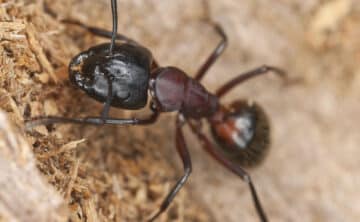
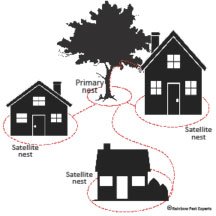
How do carpenter ants get into my house?
Carpenter ants like to live in soft wood near a source of moisture. The main nests are usually outdoors, often in big mature trees, rotten tree stumps, logs, or old lumber. From there, they enter houses along the foundation, or by following a tree branch that touches the house. They can also be carried in on firewood.
Satellite nests are often found in decks, porches, or house walls. Ants are also attracted to damp areas of the home. Think bathrooms, under tubs or sinks, under roof beams, around windows, or where there is wood near the home’s foundation. Fighting damp conditions in and around your home is the best preventative measure you can take against carpenter ants.
Five Facts About Carpenter Ants
- They do NOT actually eat wood. They cause damage when they carve out tunnels and “galleries” to use for nests. Soft, water-damaged wood is especially good for this.
- They do eat many other things found in houses, like sweets such as honey, sugar or syrup, meat, pet food, and other insects.
- Carpenter ants are active at night, especially between sunset and midnight. You may be able to hear a rustling sound near a nest, even through a wall.
- It’s common to find them in the spring.
- They can be tough to identify. Even members of the same species can look very different because they are highly specialized according to their job in the colony.
How can I tell the difference between a black ant and a carpenter ant?
Carpenter ants are generally larger than other types of ants commonly found in homes. Their shape differs as well, with their middle section (thorax) looking more rounded. They are also most active at night. You may be able to hear a crackling or rustling sound if there is a nest in your home.
How can I tell if I have carpenter ants?
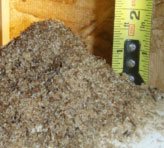
How do I get rid of carpenter ants in my home?
Step 1: Hire a pest expert—this is one time the DIY approach can’t do enough.
- Carpenter ants reproduce quickly, and they can only be eliminated with products that last long enough to control them.
- There are no slow-acting, non-repellent products available over the counter for treating carpenter ants.
- Additionally, over-the-counter products don’t work because they only target visible ants and their satellite colonies—not the main colony.
Step 2: Locate and treat all nests, including the main colony.
- Get professional help to locate and treat every active nest, including the main colony, with a professional grade carpenter ant control product.
- The main colony may be difficult to find since it may not even be on your property.
- Professionals are trained at locating nests, which can speed up the process and produce better results.
- If the main colony remains, it will continue to breed new ants, and the infestation will go on.
- Professional ant control products are designed so the ants bring the product back to nests, including the main colony, regardless of how far away it is.
Step 3: Inspect your yard and home to eliminate conditions that attract ants.
- Be sure to eliminate areas that attract ants, such as leaf litter and damp or rotting wood.
- Repair plumbing leaks or roof leaks.
Step 4: Remove and replace water-damaged wood if possible.
- Finally, once the ants have been eliminated and the conditions that attract them have been addressed, you’re ready to repair damage.
- If the source of water has been repaired and the area will remain dry, you may not need to replace wood that is structurally sound.
How can I prevent future carpenter ant problems?
The advice offered in our Spring Cleaning and Pest Control Tips also applies to avoiding carpenter ants. Most noteworthy, keep trees and shrubs properly pruned to avoid contact with the home. Never store wood material near the house, and eliminate moisture in the home.
Other items you may be interested in:
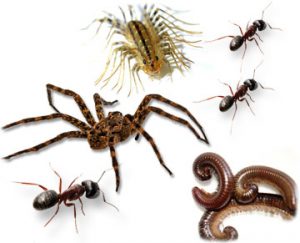
Spring Pest Control Tips for Your Minneapolis Home
It seems to happen every spring across the Minneapolis and St. Paul area. You may see one lone ant, and then seemingly overnight, there’s an
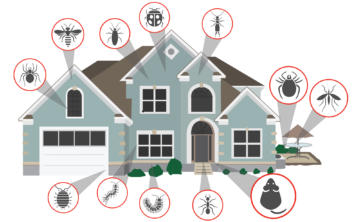
Pest Protection Plans
Enjoy year-round peace of mind for about the same cost as two or three individual service treatments.
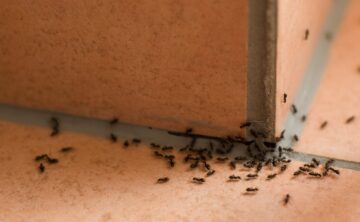
Ant Control
Our experts can protect your home against ants with a one-time service or as part of a Pest Protection Plan.




